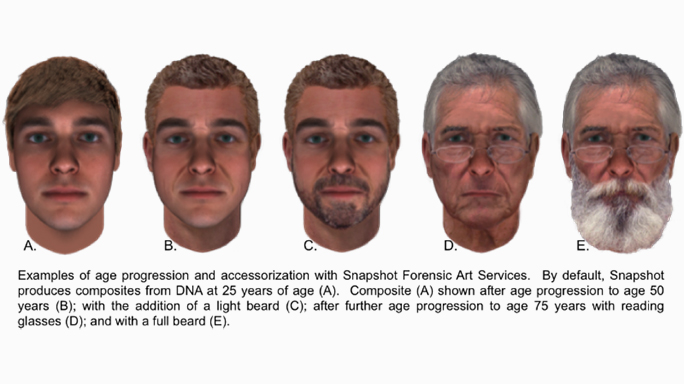The following is a release from Parabon NanoLabs:
Parabon NanoLabs, Inc. (Parabon) announced Tuesday at the International Homicide Investigators Association annual meeting in Washington, DC, a new suite of forensic art capabilities to complement the company’s Snapshot DNA Phenotyping Service, a first-of-its-kind forensics offering that can interrogate an evidentiary DNA sample and produce an accurate composite image of the source.
- RELATED STORY: New Hair Dye Technology Could Help Police with Forensics
The talent behind Parabon’s new offering is Thomas “Thom” Shaw, a veteran forensic artist, certified by the International Association for Identification (IAI), with special training in age progression and facial reconstruction from skulls.
Advertisement — Continue Reading Below
Shaw’s skillset also includes the ability to add “accessories” to a composite, such as eyeglasses, piercings or facial hair. In addition to his forensic artist position at Parabon, Shaw is also a Police Captain with 29 years of law enforcement experience in Northern Virginia.
Snapshot Division Leader, Dr. Ellen Greytak, welcomed the latest addition to the Parabon Snapshot team, stating, “The addition of Shaw’s forensic art capabilities perfectly complements the information Snapshot can derive from DNA. In situations where investigators have descriptive information about a subject that is not encoded in DNA, such as an estimate of age or information indicating a subject has facial hair, Shaw can expertly enhance a Snapshot composite accordingly.”
Facial reconstruction from skulls is another of Shaw’s talents. When combined with Snapshot, such reconstruction can be particularly helpful for the identification of unidentified remains. Snapshot currently predicts external facial morphology from DNA alone. When available, detailed information about the actual bone structure of a skull can be used to confirm or enhance the corresponding Snapshot composite.
Advertisement — Continue Reading Below
In some missing persons cases, DNA from skeletal remains is compared to that of potential family members in hopes of making an identification. Whereas traditional DNA analysis methods used in missing person cases can only match against a DNA database or DNA from a parent, Snapshot provides an accurate composite of an individual from DNA extracted from remains and can perform kinship analysis out to six degrees of relatedness.
“Especially when coupled with Shaw’s facial reconstruction techniques, Snapshot is positioned to greatly assist families and investigators with the identification of the more than 10,000 persons in the United States whose remains have not been identified,” said Greytak.
Shaw added, “I am delighted to have the opportunity to help Parabon revolutionize DNA forensics by applying my craft. It’s been my dream to make a significant contribution to forensics through the combination of science and art.”
Advertisement — Continue Reading Below
Parabon is exhibiting at the 2015 Annual IHIA Training Symposium being held in Washington, D.C. The Symposium, in its 22nd year, is designed to provide educational training to federal, state, local and international professionals involved in the investigation of violent crimes and death with the training on the latest techniques and methodologies in solving crimes.
























